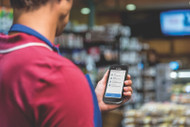Consumer VS. Enterprise Mobile Devices
Published by Mark Cramer on 1st Oct 2020
It isn’t uncommon for people to have personal mobile devices for messages, social media and gaming apps, as well as a separate work phone for emails and business use.
Consumer smartphone devices are now used in many industries, including retail and healthcare, and are popular due to their small, fit-in-pocket design and friendly interface which requires minimal training amongst staff.
The consumer device is all about the end-user experience, which ultimately benefits your workers, but how can ensure that your workers have maximum productivity?
Introducing Zebra’s Enterprise Mobile Devices. They’re durable, lightweight and are powered by Android. It’s said to be the ultimate device to increase worker productivity.
Why? Let’s Compare.
Updates
Mobile devices are always in need of an update. With consumer devices, updates are always up to the end-user, which can lead to putting off updates for convenience, or device updates at peak times. With Zebra’s Enterprise Mobile Devices, your IT department have complete control. They determine when (often during off hours to reduce network loading during peak times), and which device needs updating.
Temperature/Storage
If your workers work in hostile environments, such as in extreme temperatures or places where there’s a lot of dust and dirt likely to get within the device, it’s vital to make sure that your devices are rugged and able to withstand extreme conditions. Consumer devices generally have very limited operating and storage range, with the possibility of devices becoming dysfunctional, and no longer in use. Consumer devices are also not built with healthcare in mind, making them harder to clean and disinfect. With Zebra Devices, you can ensure a best-in-class rugged design, which withstands extreme environments, as well as easy cleaning and disinfecting for critical operations such as Healthcare, where this is vital.
Screen Size
Consumer devices tend to have smaller screens than Enterprise devices. Larger screens are said to increase productivity due them being easier to read and use, as well as easier portrait and landscape options.
Expansion Slot
Expansion slots are crucial for data backup, and memory expansions. Some consumer devices do not offer removable media (SD Cards/Flash Drives), whereas with Zebra Devices, there is an option to request removable storage.
Batteries
Some consumer devices are known to have a sparse battery life for a full shift. As well as no option to replace it affordably or quickly. With Zebra Devices, you can ensure battery life endures even the longest shift, with options to remove the battery to charge, or replace it in an efficient manner.
Lifecycle
Consumer devices tend to have a short lifecycle of just a year. Bringing the complexities of changing devices, as well as costly expenses. Zebra devices tend to have a lifecycle of 6-10 years. Even though enterprise devices have more of an upfront cost, in the long run, long lifecycles, and productivity enhancing tools can cut your TCO in half.
With consumer devices, you tend to have to look elsewhere for an insurance or warranty plan. With Zebra Devices, you can rely on Zebra OneCare to maximize your device uptime and business performance. Consumer
You can find more about OneCare here.
For more information regarding a Zebra Enterprise Mobile Device, or switching from Consumer Devices, feel free to contact us.
